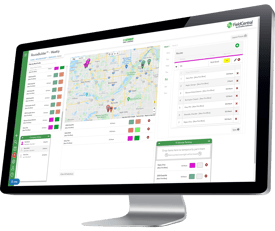By David Crary
Note: This is the first in a series of blog posts with tips aimed at helping field service businesses improve during seasonal slow periods.
“If you don't know where you are going, you'll end up someplace else.”
- Yogi Berra
 So you own an irrigation business in a northern climate and it’s the middle of December. You don’t have a lot to do, right? Wrong. The offseason is when you set yourself up for success. Over the next couple of weeks, we’ll be writing about ways you can improve your field service business during seasonal slow periods.
So you own an irrigation business in a northern climate and it’s the middle of December. You don’t have a lot to do, right? Wrong. The offseason is when you set yourself up for success. Over the next couple of weeks, we’ll be writing about ways you can improve your field service business during seasonal slow periods.
Our first tip? Set goals. Now that you’ve have some time to step back from the daily grind, start thinking strategically about where you want your business to be at this same time next year. Then, set goals that will help you to get there.
Be SMART
Most businesses set goals. But not all businesses set SMART goals. What makes a goal SMART? Easy, just make your goals:
Specific
Your goals should be as specific as possible. For example, don’t set a goal to grow revenue. Set a goal to grow revenue by 10 percent. Also, in order to be specific, your goal should answer the five W questions: What, Why, Who, Where and Which.
Measurable
The great thing about our previous goal – growing revenue by 10 percent – is that it’s measurable. In fact, it’s one of the easiest things for your business to measure. Or, if you use HindSite’s field service software, you can set a goal of increasing billable time by 10%. Whatever your goal, make sure it’s measurable – and the easier to measure, the better. If it’s not measurable, it’s going to be very hard to determine if you were successful.
Attainable
Just like you wouldn’t expect a baseball player to set a goal of hitting .500 in 2013, you shouldn’t set unattainable goals. Likewise, you don’t want goals that are easily achieved. Find a happy medium. For instance, if you grew revenue by 5% the previous year, set a goal to grow it by 7% next year. Use your past experience and expectations for the coming year to set attainable goals.
Relevant
Let’s pretend you own a lawn care business. Setting a goal to open a new shoe store isn’t relevant to your lawn care business. Find metrics that matter to your business. For HindSite, we set both customer and license goals. Why? Because we could have a lot of customers with a few licenses, and subsequently little revenue. We also want to grow the licenses within our customer base (because, ultimately, we make money off of licenses, not customers). The number of customers is a good goal, but it’s not entirely relevant to our profitability.
Timely
Add a time element to your goals. For instance, setting a goal to have $5 million in revenue isn’t really timely. When are you going to have $5 million in revenue? Next year? In 2050? Be sure to specify by when a goal should be achieved.
Planning for Success
Once you’ve set your goals, don’t forget to spend a considerable amount of time determining how to achieve them. Goals are great, but if you don’t put together a detailed plan for how to achieve them, you’ve wasted time creating them.
Let’s assume, for a second, that we’ve set a goal of 200 sales next year. What would we need to do to get to that goal? For HindSite, we’d want to make sure we have enough leads in the pipeline to achieve that goal. Let’s assume we historically close 20% of our leads – that means we’d need to generate 1000 new leads next year. How are we going to do that? Are we going to attend trade shows? Spend more on advertising? Leverage internet marketing? We’d need a very clear plan for how to achieve our goal of 200 new sales. And so do you.
Cascading Goals
Something else to consider is how to communicate your goals internally and cascade them throughout your organization. Our advice: keep hammering home your goals. Create a dashboard that shows your progress toward your goal and update it as frequently as possible. Celebrate your wins with your team. At every meeting you have, talk about your goals and how close you are to completing them. The more you talk about your goals, the more people will remember – and work towards them.
It’s also important to set goals that you can cascade throughout your organization. If you have a revenue goal, make sure your sales reps have individual goals that add up to your company goal. If you have a customer retention goal, make sure the crews that service customers also have retention goals. By trickling your goals down to individuals, you’re holding your entire organization accountable for your company goals in some way.
If you review your employees, make sure that the SMART goals you’ve cascaded down within your organization are discussed at every review. The easiest way to have your employees internalize – and achieve – your goals is to have them be an intricate part of their employee review.
Setting goals is a valuable exercise that can help you improve and grow your organization. What better time to finalize your goals than when you have time to breathe during the offseason?







